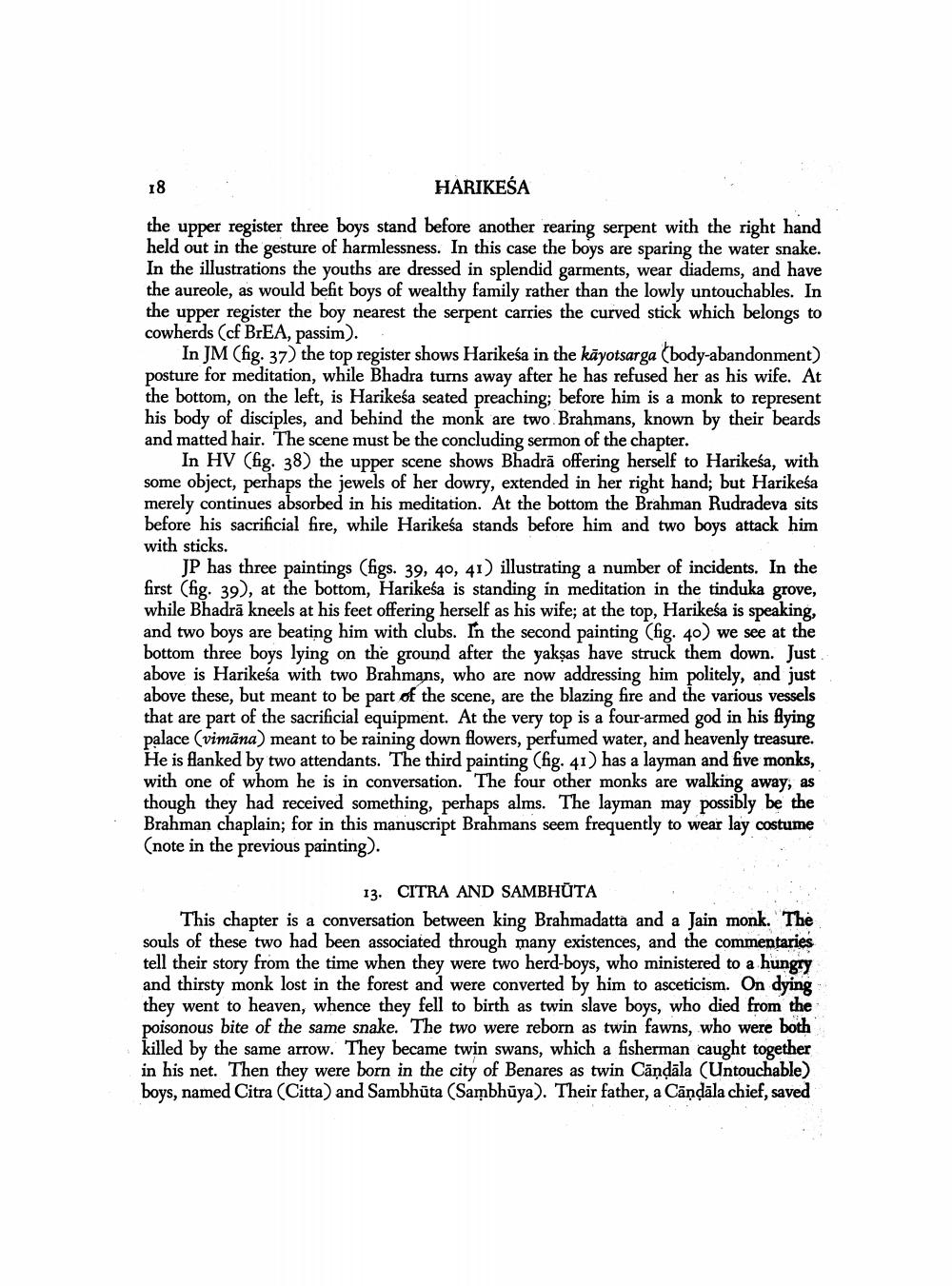________________
18
HARIKEŚA
the upper register three boys stand before another rearing serpent with the right hand held out in the gesture of harmlessness. In this case the boys are sparing the water snake. In the illustrations the youths are dressed in splendid garments, wear diadems, and have the aureole, as would befit boys of wealthy family rather than the lowly untouchables. In the upper register the boy nearest the serpent carries the curved stick which belongs to cowherds (cf BrEA, passim). .
In JM (fig. 37) the top register shows Harikeśa in the kāyotsarga (body-abandonment) posture for meditation, while Bhadra turns away after he has refused her as his wife. At the bottom, on the left, is Harikeśa seated preaching; before him is a monk to represent his body of disciples, and behind the monk are two Brahmans, known by their beards and matted hair. The scene must be the concluding sermon of the chapter.
In HV (fig. 38) the upper scene shows Bhadrā offering herself to Harikeśa, with some object, perhaps the jewels of her dowry, extended in her right hand; but Harikeśa merely continues absorbed in his meditation. At the bottom the Brahman Rudradeva sits before his sacrificial fire, while Harikeśa stands before him and two boys attack him with sticks.
JP has three paintings (figs. 39, 40, 41) illustrating a number of incidents. In the first (fig. 39), at the bottom, Harikeśa is standing in meditation in the tinduka grove, while Bhadrā kneels at his feet offering herself as his wife; at the top, Harikeśa is speaking, and two boys are beating him with clubs. In the second painting (fig. 40) we see at the bottom three boys lying on the ground after the yakşas have struck them down. Just above is Harikeśa with two Brahmans, who are now addressing him politely, and just above these, but meant to be part of the scene, are the blazing fire and the various vessels that are part of the sacrificial equipment. At the very top is a four-armed god in his flying palace (vimāna) meant to be raining down flowers, perfumed water, and heavenly treasure. He is flanked by two attendants. The third painting (fig. 41) has a layman and five monks, with one of whom he is in conversation. The four other monks are walking away, as though they had received something, perhaps alms. The layman may possibly be the Brahman chaplain; for in this manuscript Brahmans seem frequently to wear lay costume (note in the previous painting).
13. CITRA AND SAMBHUTA This chapter is a conversation between king Brahmadatta and a Jain monk. The souls of these two had been associated through many existences, and the commentaries tell their story from the time when they were two herd-boys, who ministered to a hungry and thirsty monk lost in the forest and were converted by him to asceticism. On dying they went to heaven, whence they fell to birth as twin slave boys, who died from the poisonous bite of the same snake. The two were reborn as twin fawns, who were both killed by the same arrow. They became twin swans, which a fisherman caught together in his net. Then they were born in the city of Benares as twin Cāņdāla (Untouchable) boys, named Citra (Citta) and Sambhūta (Sambhūya). Their father, a Cāņdāla chief, saved




